Under the magnifying glass: The benefits of display digital advertising (Part III)
Part III: Going further: the future of display DOOHFollowing on from our articles on the General Benefits of Display DOOH and on theDynamic use of display DOOH, this third and last part will be focusing on the future opportunities that display DOOH will bring to advertisers.
We believe that the growth of digital in display OOH’s large audience venues will continue in pace and probably accelerate in the coming years. New opportunities for engagement will also arise as the number of people spending time out of home increases, along with the number of people using smartphone devices to stay connected to the world whatever their location.
Following the success of large digital screens to make bold statements in Airports, the same strategy is being applied in Mall environments. JCDecaux UK for instance is launching large digital screens in malls across the country in conjunction with the smaller 6-sheet displays. This enables brands to be highly visible across the busy mall environments and to drive the audience towards the shops.
M-VISION are large format digital displays designed to complement and amplify the reach of the digital 6-sheets installed in shopping malls across the UK. M-vision helps to reach millions of shoppers by delivering massive impact along with great flexibility and the ability to run time-sensitive and multiple messaging.
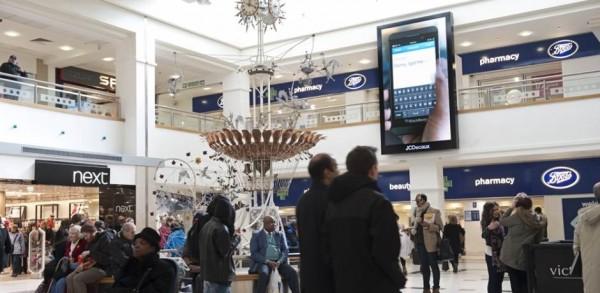
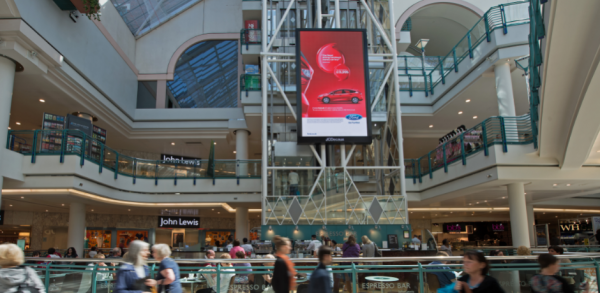 Similarly, supermarkets are now taking the route towards digitalisation of their OOH products to create engaging content. Again thanks to the flexibility of DOOH, brands can easily adapt their messages to respond to various factors such as spontaneous special offers or specific content according to the time of day to target each type of shopper that goes through the supermarket during the day.
JCDecaux has been at the forefront of these latest developments, having just launched 400 new digital screens outside Tesco stores across the UK. “Advertisers will soon be able to target shoppers by day of the week and time of the day […] to optimise their ad campaigns by four parts of the day”(Spencer Berwin, MD JCDecaux, for MediaWeek - 14th June 2013).
Similarly, supermarkets are now taking the route towards digitalisation of their OOH products to create engaging content. Again thanks to the flexibility of DOOH, brands can easily adapt their messages to respond to various factors such as spontaneous special offers or specific content according to the time of day to target each type of shopper that goes through the supermarket during the day.
JCDecaux has been at the forefront of these latest developments, having just launched 400 new digital screens outside Tesco stores across the UK. “Advertisers will soon be able to target shoppers by day of the week and time of the day […] to optimise their ad campaigns by four parts of the day”(Spencer Berwin, MD JCDecaux, for MediaWeek - 14th June 2013).
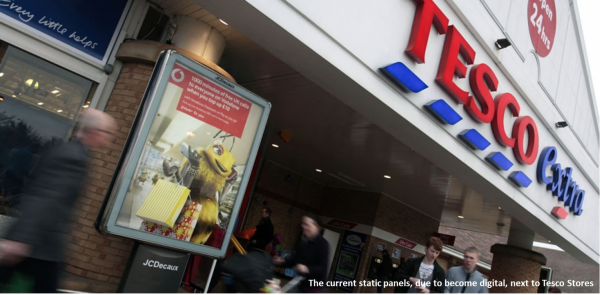 But digital is not just about DOOH screens. It is also about OOH and DOOH’s ability to interact with the audience through the use of connected devices. As mobility is quickly reshaping driven by the strong penetration of smartphones and the technologies that they carry, OOH and DOOH are introducing new ways to target and engage with audiences across all environments.
Out-of-home advertising is undergoing some changes with the arrival of these new technologies - Internet connectivity, real-time content, NFC and QR scanning, App downloads and many more, are bringing new opportunities to use OOH as a connected medium. Brands are now adapting the content that is delivered to the audience according to the final result that they wish to reach…
In an example of the use of smartphone with OOH for VIRTUAL SHOPPING, whether it be Woolworths on Roadside in Australia, Pricerite Express in the Hong Kong Metro or Nautica at the New York Airports, each offered an opportunity to purchase products directly from the panels through the use of smartphone-enabled technologies.
Woolworths offered consumers the possibility to download their App in order that they may scan the barcodes of the products displayed on the bus shelter to add them to a virtual shopping list. Consumers could then find out where the nearest store was as well as if it had the items in stock or they could order the items directly online.
But digital is not just about DOOH screens. It is also about OOH and DOOH’s ability to interact with the audience through the use of connected devices. As mobility is quickly reshaping driven by the strong penetration of smartphones and the technologies that they carry, OOH and DOOH are introducing new ways to target and engage with audiences across all environments.
Out-of-home advertising is undergoing some changes with the arrival of these new technologies - Internet connectivity, real-time content, NFC and QR scanning, App downloads and many more, are bringing new opportunities to use OOH as a connected medium. Brands are now adapting the content that is delivered to the audience according to the final result that they wish to reach…
In an example of the use of smartphone with OOH for VIRTUAL SHOPPING, whether it be Woolworths on Roadside in Australia, Pricerite Express in the Hong Kong Metro or Nautica at the New York Airports, each offered an opportunity to purchase products directly from the panels through the use of smartphone-enabled technologies.
Woolworths offered consumers the possibility to download their App in order that they may scan the barcodes of the products displayed on the bus shelter to add them to a virtual shopping list. Consumers could then find out where the nearest store was as well as if it had the items in stock or they could order the items directly online.
 Pricerite Express took to the Hong Kong metro in order to offer commuters the opportunity to purchase their items through the use of QR codes while waiting for their train. Each purchased item would then be delivered directly to people’s doors.
Pricerite Express took to the Hong Kong metro in order to offer commuters the opportunity to purchase their items through the use of QR codes while waiting for their train. Each purchased item would then be delivered directly to people’s doors.
 American clothing brand Nautica launched a groundbreaking campaign around the period of Christmas at New York's JFK International and LaGuardia Airports. Wall wraps that displayed some of the brand’s clothes were installed in high traffic areas of each airport to act as virtual storefronts. Thanks to the use of QR codes, travellers could order online right then and there, resulting in the brand seeing a total of 530 orders over a 4 week period.
American clothing brand Nautica launched a groundbreaking campaign around the period of Christmas at New York's JFK International and LaGuardia Airports. Wall wraps that displayed some of the brand’s clothes were installed in high traffic areas of each airport to act as virtual storefronts. Thanks to the use of QR codes, travellers could order online right then and there, resulting in the brand seeing a total of 530 orders over a 4 week period.
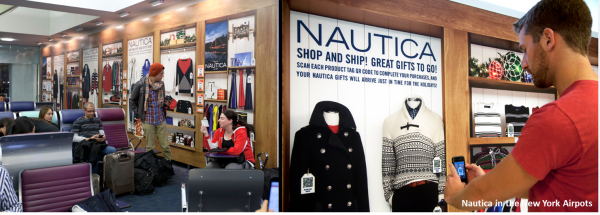 Smartphone technologies can be put to many other uses besides virtual stores. Competitions, prizes, vouchering, sampling, downloading content and many more activities can be carried out by brands thanks to smartphones.
In a good example of the use of smartphone with OOH to ENTER A PRIZE-WINNING COMPETITION, HP customized an entire bus shelter and had QR codes displayed on all of its panels across the city of Amsterdam to advertise for the launch of its new 14” ultrabook. By scanning a QR code, the audience entered a competition for the chance to win the new product for free. Within 1 week, the brand registered 4,500 interactions with the panels.
Smartphone technologies can be put to many other uses besides virtual stores. Competitions, prizes, vouchering, sampling, downloading content and many more activities can be carried out by brands thanks to smartphones.
In a good example of the use of smartphone with OOH to ENTER A PRIZE-WINNING COMPETITION, HP customized an entire bus shelter and had QR codes displayed on all of its panels across the city of Amsterdam to advertise for the launch of its new 14” ultrabook. By scanning a QR code, the audience entered a competition for the chance to win the new product for free. Within 1 week, the brand registered 4,500 interactions with the panels.
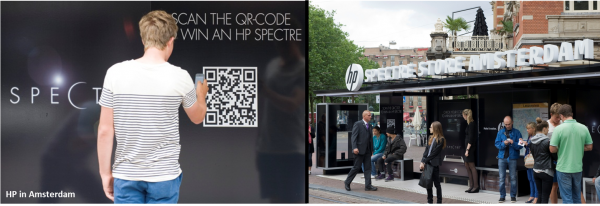 In a further example concerning the use of smartphone with OOH to DOWNLOAD CONTENT, Samsung in the USA and SONY in the UK both decided to offer their audience the opportunity to download free music by tapping the NFC tags available on the panels.
Samsung approached the affluent audiences at the Airport and the larger audiences at the Mall and on the Street with a simple but straight to the point message inviting them to download free music via the NFC tag.
SONY on the other hand gave its Mall campaign a twist by adding some innovative content in the form of a sound shower. Shoppers could only hear the music when they stood under the sound shower and were then invited to download it free by tapping the NFC tag.
In a further example concerning the use of smartphone with OOH to DOWNLOAD CONTENT, Samsung in the USA and SONY in the UK both decided to offer their audience the opportunity to download free music by tapping the NFC tags available on the panels.
Samsung approached the affluent audiences at the Airport and the larger audiences at the Mall and on the Street with a simple but straight to the point message inviting them to download free music via the NFC tag.
SONY on the other hand gave its Mall campaign a twist by adding some innovative content in the form of a sound shower. Shoppers could only hear the music when they stood under the sound shower and were then invited to download it free by tapping the NFC tag.
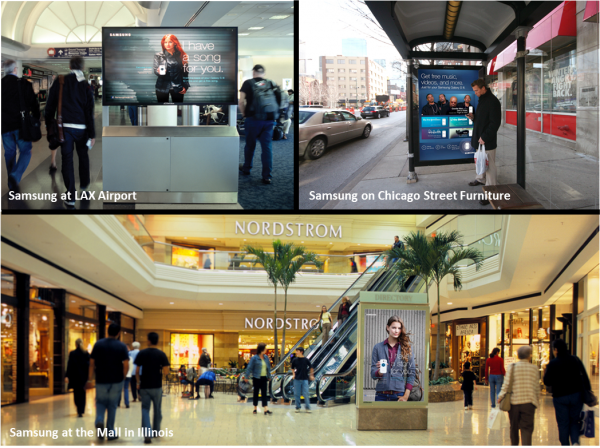
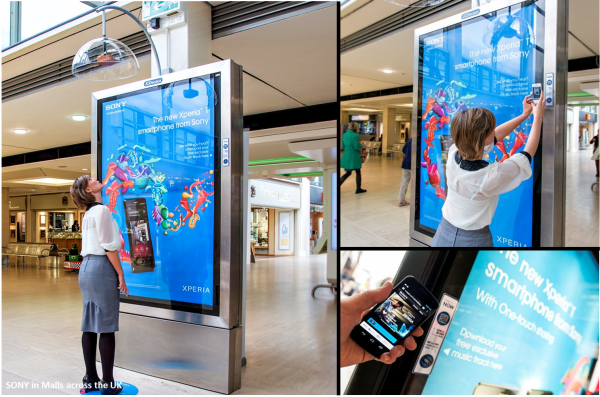 Finally in an example concerning the use of smartphone with OOH for VOUCHERINGMorrison’s, as part of a research on QR and NFC that was carried out by JCDecaux and other media owners in the town of Reading in 2012, offered for the audience to download vouchers to use in the nearest store. The results of the study show that vouchering had the highest percentage of conversions across all contents tested.
Finally in an example concerning the use of smartphone with OOH for VOUCHERINGMorrison’s, as part of a research on QR and NFC that was carried out by JCDecaux and other media owners in the town of Reading in 2012, offered for the audience to download vouchers to use in the nearest store. The results of the study show that vouchering had the highest percentage of conversions across all contents tested.
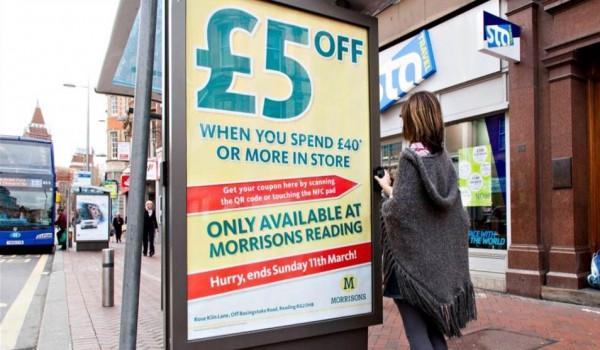 With smartphones giving people the ability to engage with many types of contents on the go, brands are developing ever more original solutions to get closer to their audiences. Another more simple use of the smartphone in relation to OOH is by using the medium to leverage visits to brands’ social pages.
In one of many examples of this development, Europcar used a Cromwell Road digital large format screen along with digital 6 sheets across the UK, to invite its audience to follow the brand’s Twitter page and send a message reacting to the campaign. Each message was then displayed on the large digital screen for everybody to see. Within a month, the brand received over 500 tweets and experienced a growth of 1,400% in its Facebook fans count.
With smartphones giving people the ability to engage with many types of contents on the go, brands are developing ever more original solutions to get closer to their audiences. Another more simple use of the smartphone in relation to OOH is by using the medium to leverage visits to brands’ social pages.
In one of many examples of this development, Europcar used a Cromwell Road digital large format screen along with digital 6 sheets across the UK, to invite its audience to follow the brand’s Twitter page and send a message reacting to the campaign. Each message was then displayed on the large digital screen for everybody to see. Within a month, the brand received over 500 tweets and experienced a growth of 1,400% in its Facebook fans count.
 Display OOH is an adaptable medium which offers creative solutions for mobile interaction. OOH and therefore DOOH act as last calls, prompting the audience to interact through the use of their mobile phones and the many technologies that they carry.
DOOH still has years of strong growth ahead, thanks to the new interactivity that is made possible by the technology. It will offer many new solutions to advertisers by enabling them to benefit from added flexibility, and an ability to engage with consumers in real-time.
Through this three-part series of insight pieces, we have shown that DOOH is a medium with an ever growing importance in advertisers’ media strategies. As we carry on implementing new technologies across all OOH environments and further enhance interactivity with smartphones, advertisers will discover more original ways to engage and strengthen their special connections with their consumers...
For more information and insights on the subject, or if you wish to talk to one of our sales experts, please get in touch by clicking the “Contact Us” button or leave your comments below.
Display OOH is an adaptable medium which offers creative solutions for mobile interaction. OOH and therefore DOOH act as last calls, prompting the audience to interact through the use of their mobile phones and the many technologies that they carry.
DOOH still has years of strong growth ahead, thanks to the new interactivity that is made possible by the technology. It will offer many new solutions to advertisers by enabling them to benefit from added flexibility, and an ability to engage with consumers in real-time.
Through this three-part series of insight pieces, we have shown that DOOH is a medium with an ever growing importance in advertisers’ media strategies. As we carry on implementing new technologies across all OOH environments and further enhance interactivity with smartphones, advertisers will discover more original ways to engage and strengthen their special connections with their consumers...
For more information and insights on the subject, or if you wish to talk to one of our sales experts, please get in touch by clicking the “Contact Us” button or leave your comments below.











